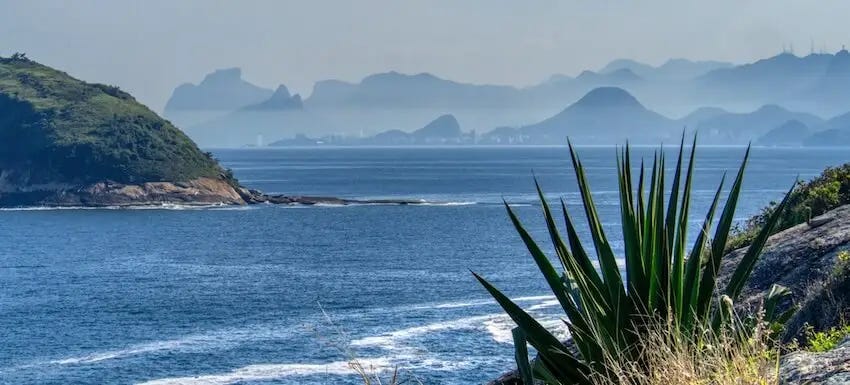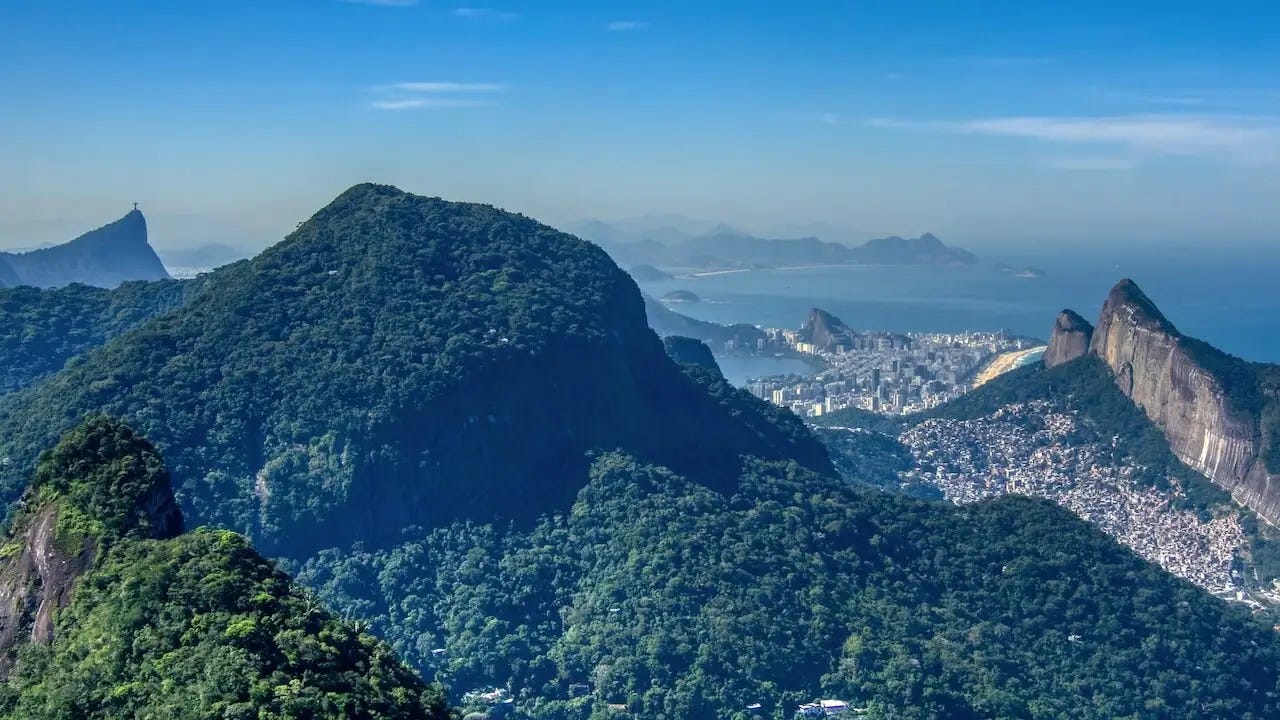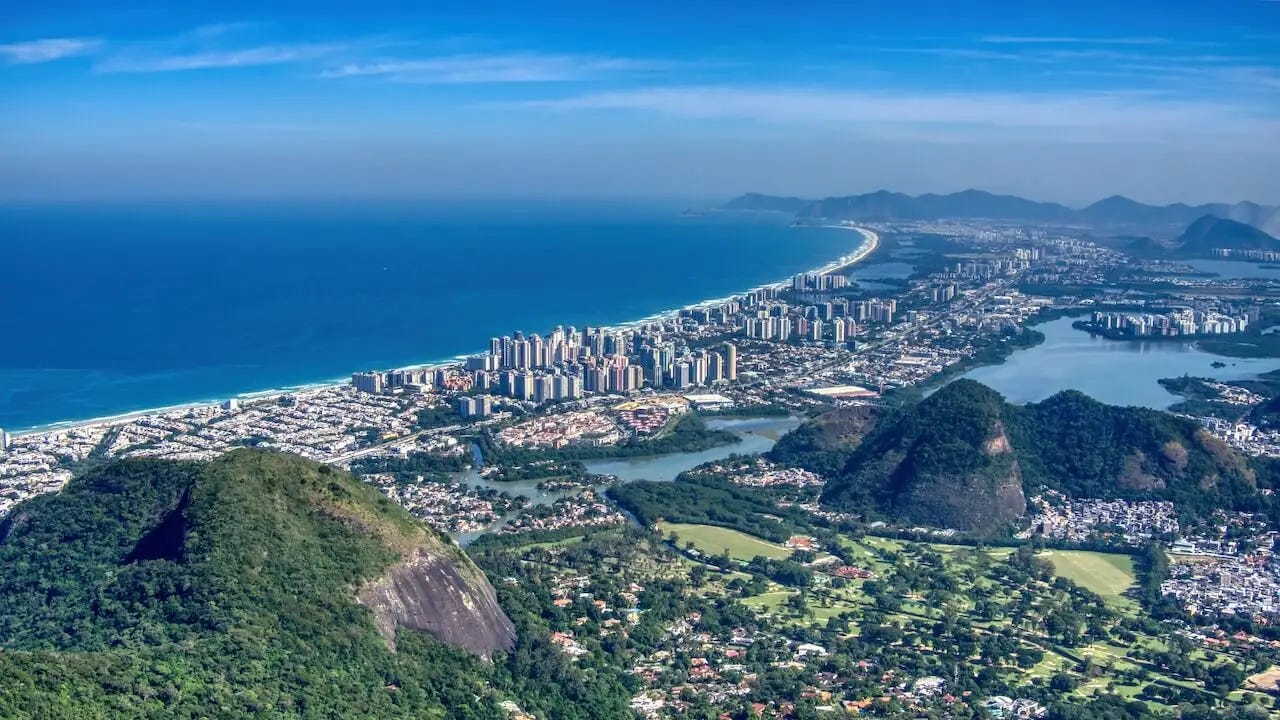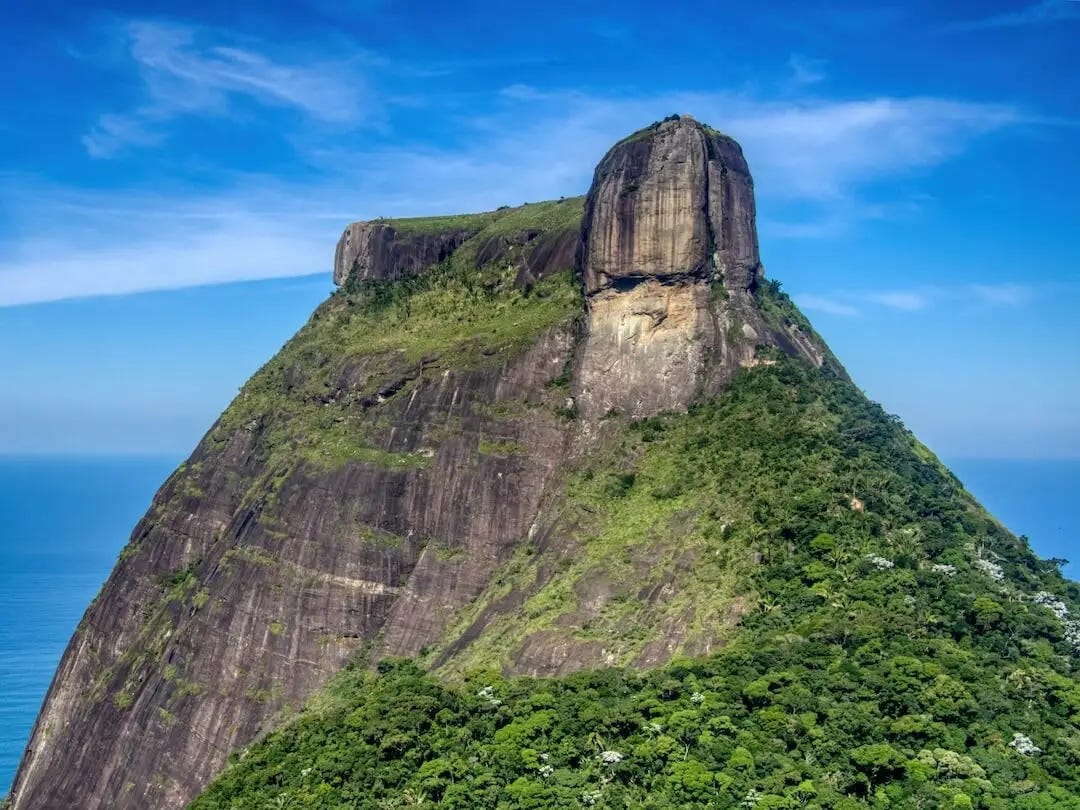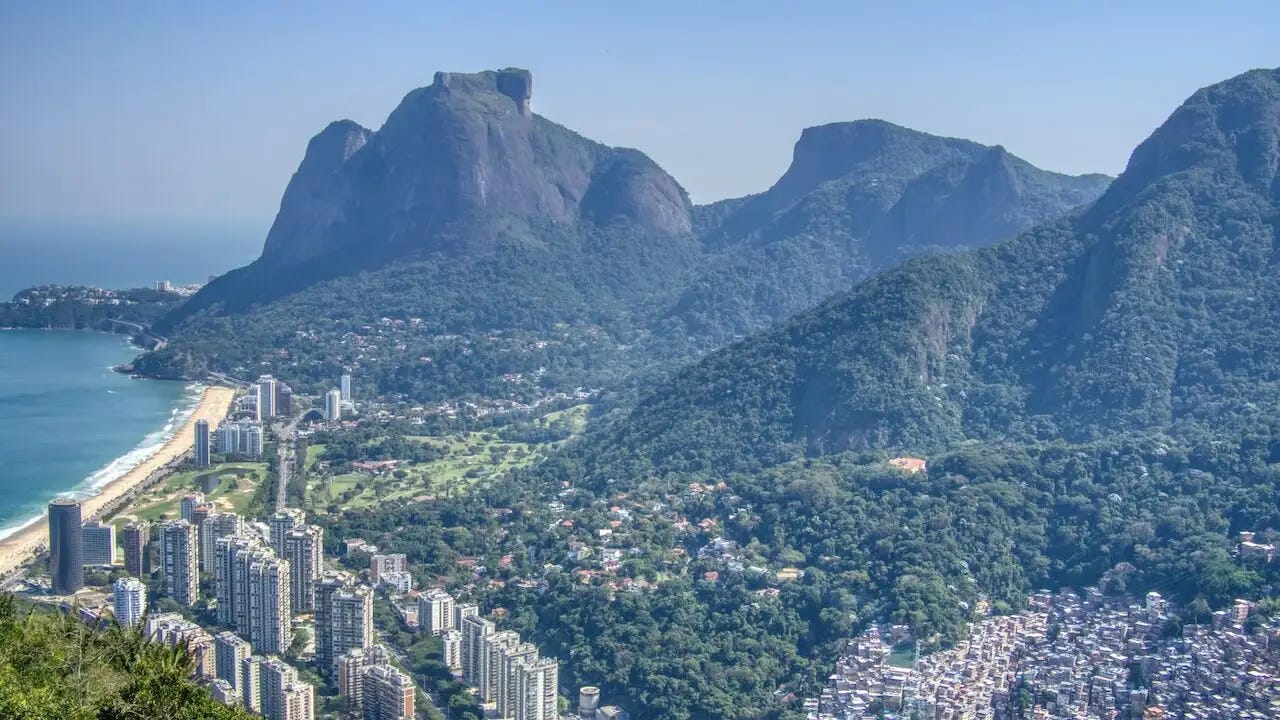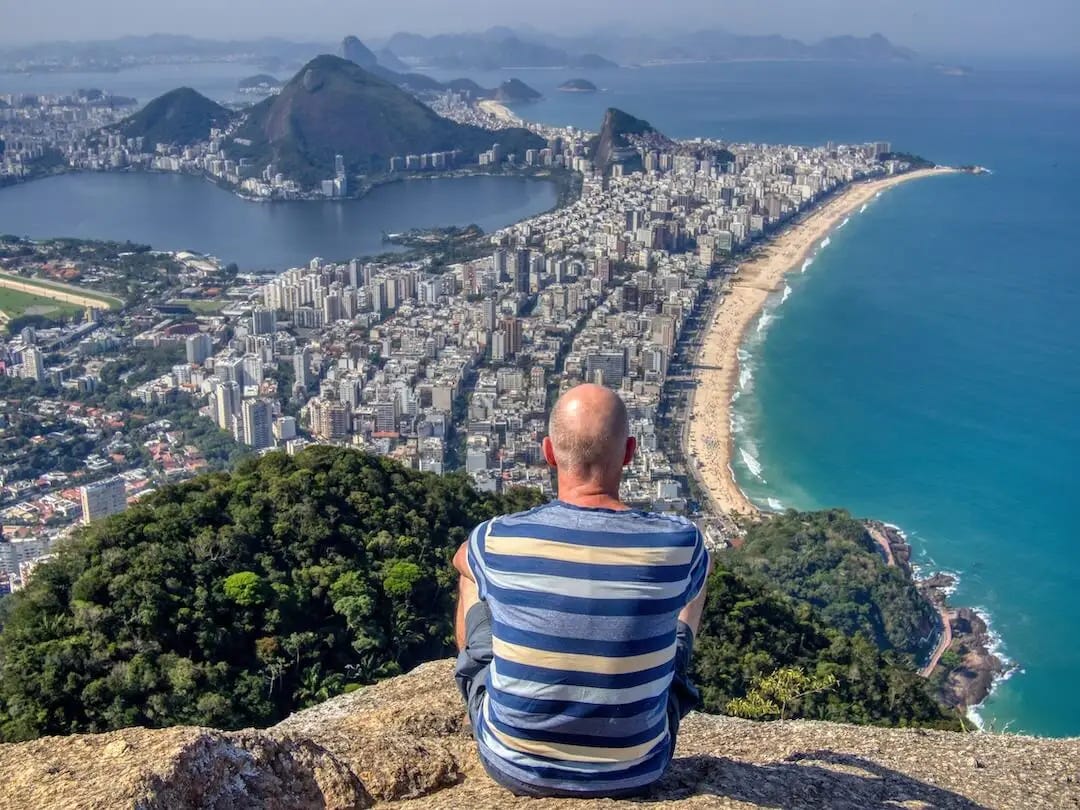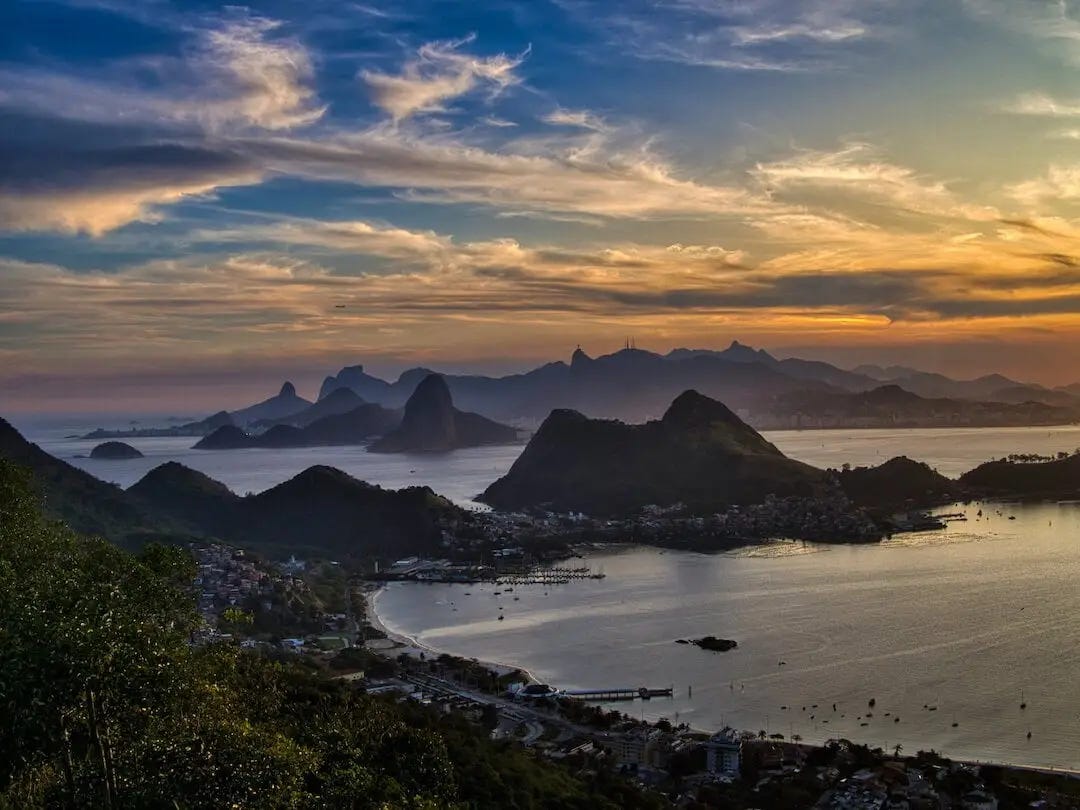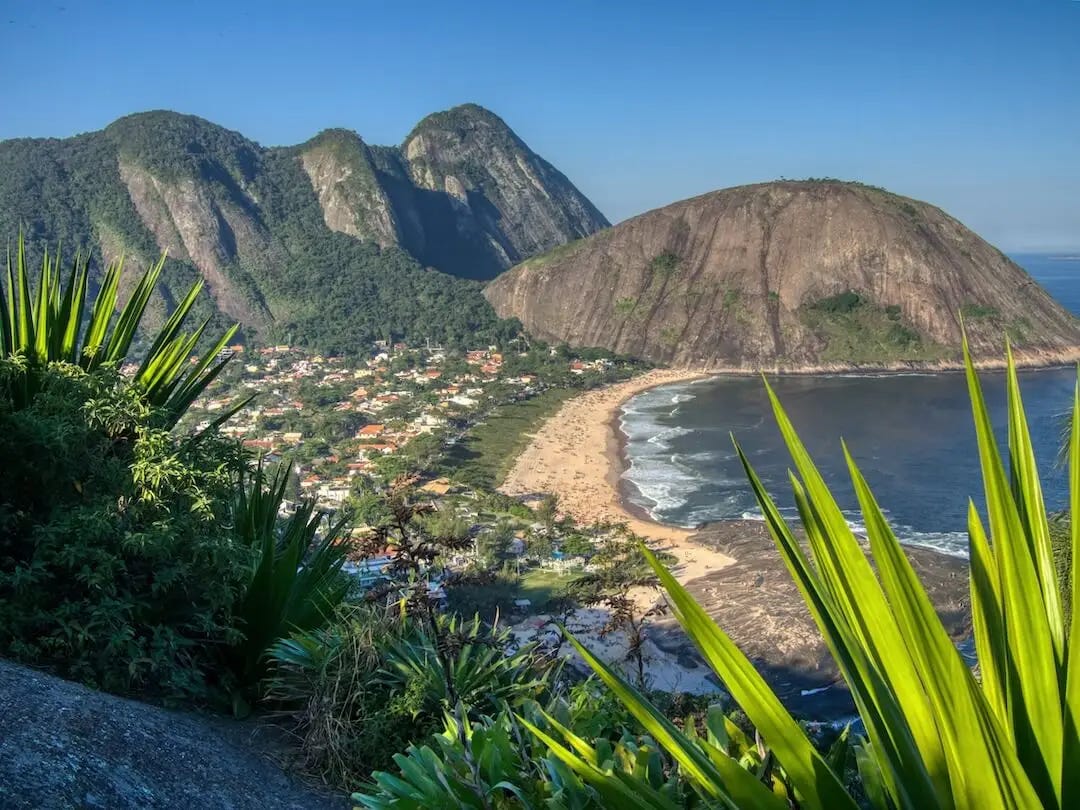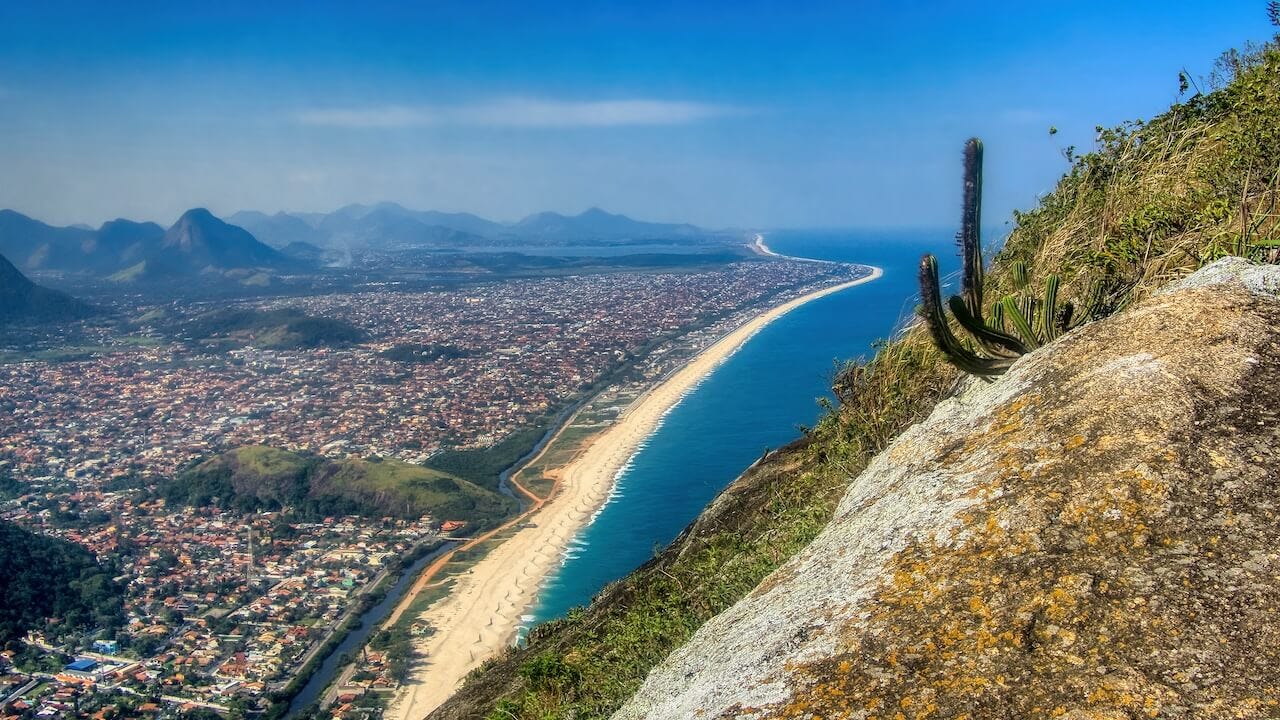6 Of The Best Hikes In Rio de Janeiro For Amazing Views
Selecting the best hikes in Rio de Janeiro is a thankless task – but here are six of our favourites, each with stunning views.
Rio’s landscape is a wild combination of jagged mountains, rainforest-covered hillsides and sublime beaches. More than just a photographer’s paradise, it’s also a major centre for fantastic hiking. Especially when the trail finishes with one of the many world-class views the region has to offer.
So, if you plan to visit the city soon, we’d heartily recommend you include at least one hike to complement your sightseeing, beach time and samba school lessons.
In this post, we’ll suggest six of the best hikes in Rio de Janeiro, based on our own experience. Each one of them boasts phenomenal views of both the city and coastline. And they can all be completed in two to three hours.
We’ve also included those to be found in Niterói, a city on the other side of Guanabara Bay, which is easily accessible from downtown Rio via a short ferry crossing.
Disclosure: This page contains affiliate links, which means that if you ultimately make a purchase, we earn a small commission at no extra cost to you. And it helps to keep our content free!
Pedra Bonita
Getting there: The trail is accessed from a parking area some 10 km uphill from Praia São Conrado. Our Uber dropped us off at the access road to the parking area. And there’s a bus (#448) that runs between São Conrado and Maracai that stops at the same place.
Tijuca National Park is Rio’s Atlantic rainforest centrepiece, featuring some of the city’s most iconic sites (Corcovado Mountain and Christ the Redeemer statue) and some of its most famous hikes, such as the Pica da Tijuca trail and the challenging Pedra de Gávea.
Much easier is the 45-minute hike to the summit of Pedra Bonita (“Beautiful Stone”). If anything, the steepest section is the road that leads from the bus stop or taxi drop-off point to the trailhead proper. After that, it’s a relatively easy climb through the rainforest on a well-established path.
But, once you reach the summit, the forest gives way to a huge, flat slab of granite from where the coastal views are simply magnificent.
To the left (east), the angular peaks of Tijuca National Park are carpeted with thick vegetation. The monotony of green is only broken by the bright colours of a paraglide as it soars and then drifts downwards towards São Conrado Beach. And, in the distance, the silhouetted figure of Christ the Redeemer stands proud on its elevated perch against a hazy blue sky.
Towards the coastline, South America’s largest favela, Rocinha, sits in the shadow of Dois Irmãos (the “Two Brothers”), its twin peaks seemingly pointing towards the hedonistic delights of Ipanema and Copacabana beaches. And, in the background, layer upon layer of mountain peaks fade away behind the haze.
A short wander to the right of the plateau reveals a somewhat contrasting view toward the west.
The mountainous rainforest and bizarre rock formations have now given way to the relative flatness of the Tijuca de Barra neighbourhood, with its lakes, green fields and mile-upon-mile of white-sand beach. Not to mention the high-rise buildings and residential areas that pepper the landscape. This was, after all, where the Rio Olympics of 2016 were held.
And, right in front, the imposing sight of Pedra de Gávea, a staggering monolith that rises 844 metres (nearly 2,800 feet) directly above the coastline. It’s so close that we were able to watch as groups of hikers gingerly made their way up the sheer rock section just beneath the summit. (For us that will have to wait for another day!)
If the weather is fine, this really is a place to linger. Especially if you’ve had the good sense to bring a picnic.
And, for such a straightforward hike, the payoff is so worth it.
HAVE YOU CONSIDERED HOUSE SITTING?
Over the years we've saved thousands of pounds on accommodation costs by house sitting all over the world. If you’re new to the concept but want to give it a try, you’ll need to sign up for one or more specialist websites that connect homeowners with potential house sitters.
The world’s largest platform is Trusted Housesitters, with tens of thousands of opportunities around the globe. By creating a free account with them you can preview what housesits are currently on offer, filtered by country, region or city.
You can do that by following this link and choosing the “Find a house sit” tab. If you then decide to join as a member, you’ll also receive a 25% discount on your first year’s subscription
Everything You Need To Know About House & Pet Sitting
Morro Dois Irmãos (Two Brothers)
Getting there: First, make your way to Vidigal’s favela entrance on foot (along the coast from Leblon), by bus from Ipanema/Leblon or taxi/Uber. From there, take a moto-taxi to the trailhead (10 minutes).
Looming large at the western end of Ipanema Beach, the unmistakable peaks of Morro Dois Irmãos look barely scaleable. But the good news is that as well as being iconic Rio de Janeiro landmarks, they can be hiked fairly easily, too. Or at least the taller of the two can.
That’s not to say that it doesn’t take some effort to complete. First, the trailhead starts at the top of a favela (Vidigal). You can walk up through the streets of the favela if you wish but we’d suggest you keep your strength for the actual trail. Instead, there’s the option of a madcap 10-minute moto-taxi ride up through the favela (i.e. on the back of a motorbike). And possibly without a safety helmet. Not for the faint-hearted but a true Brazilian experience nonetheless!
The favela is probably one of the safest in the city, but you need to be aware that you’ll be passing through it to start the walk.
Once at the trailhead, the pathway begins to ascend through the rainforest, before it opens near a cliff overlooking the favela of Rocinha. A precarious rocky ledge provides a better view of the sprawling neighbourhood, which breaches a valley between the Two Brothers and Tijuca National Park.
Another break in the rainforest provides another glorious view to the west of São Conrado, Pedra de Gávea and Pedra Bonita.
From here the trail gets pretty steep for a while. And it's not a section we’d want to do after it’s been raining. But it eventually rises above the tree line and, like at Pedra Bonita, opens onto a rocky plateau.
And the view from there is astonishing.
Take a seat on the bare rock and gaze out over some of Rio’s Greatest Hits – Ipanema, Copacabana, Sugar Loaf Mountain, Lagoa Rodrigo de Freitas et al. However, it can get pretty busy up there due to the lack of space, so try to start out first thing in the morning to grab your space. And, almost as importantly, try to time your visit for a clear, sunny day as you’ll see very little if there’s low cloud around.
We’ve written a separate post about the hike, so please feel free to head over there for more information.
READ MORE: Hiking Morro Dois Irmaos: The Two Brothers Of Rio
Parque Cidade de Niterói
Getting there from Rio: Take the catamaran ferry to Charitas (every hour) from the terminal at Praça XV de Novembro, then walk along the promenade towards São Franciso; turn right at Praça do Rádio Amador and follow the sign for Parque Cidade (City Park); once at the gates, follow the road until you arrive at the main car park and viewing platform. Closed Mondays.
If you ask us, the paragliding platform in Parque Cidade de Niterói has the best view of Rio de Janeiro bar none.
In truth, the walk up there is nothing to write home about. Just an extremely steep road that winds its way up through the park, with the occasional forest detour if that takes your fancy. Most people either drive up or catch a taxi – although we found both Uber and taxi drivers somewhat reluctant to make the effort.
Nevertheless, the walk up is straightforward enough. Just head inland from Praça do Rádio Amador and follow the signs for the Parque Cidade (City Park). Once you arrive at the entrance there’s a further 15-minute walk (past dozens of parked cars at the weekends) to the viewing platform.
We kid you not, the panorama that unfolds before you from there is just mindblowing. In front of you, the whole Rio skyline forms a geological masterpiece of epic proportions. All the big hitters are there in full cinemascope – The Two Brothers, Pedra de Gávea, Pedra Bonita, Sugar Loaf and Corcovado Mountain. And then there are the waterfront neighbourhoods of Copacabana, Botafogo and Flamengo, culminating in the commercial hub of the historic centre.
Over to the right, there’s a faint murmur of traffic on the vast expanse of the Niterói-Rio road bridge. And, beyond, the distinctive jagged mountains around Teresópolis. Meanwhile, in the foreground, Charitas and São Francisco beaches curve around an inlet of Guanabara Bay, forming a counterpoint to the multiple peaks in the background.
Simply stunning. And a view we never tired of seeing (we were housesitting nearby for six months, after all).
At weekends, the viewing platform gets packed with families and couples who gather in big numbers to watch the sunset. And, if there’s one place in Rio to watch a sunset from, this would be it. But be mindful that if you get up there too early you’ll be at the mercy of the ferocious sun, which blazes from across the bay.
Thankfully, the road back down is fully lit and relatively safe to walk. However, if you're relying on a taxi back, you might want to book one before setting off as the phone and 4G signals are a bit erratic up there.
READ MORE: Why You Should Visit Niteroi, Rio's Underrated Neighbour
PLANNING YOUR TRIP
FLIGHTS: We've used Skyscanner to book the majority of our flights over the years. We can also recommend Kiwi for their keen prices and great customer service.
ACCOMMODATION: When we're not house sitting we're on the lookout for affordable quality accommodation - Agoda offer discounted rates at nearly 3 million hotels and private homes around the world.
TRAVEL INSURANCE: Not just a "nice-to-have" but essential for most travel situations. As UK residents we use True Traveller, who offer general travel insurance as well as backpacker insurance with up to 2 years cover. For USA residents, Faye Insurance allow you to book and manage your cover through their innovative app. And, for digital nomads, Safety Wing offer both travel insurance and global health insurance.
CAR RENTAL: As an online booking platform, Discover Cars compare vehicle rental deals and always quotes inclusive of all mandatory fees, taxes and extras.
Remember: These are affiliate links, which means that if you ultimately make a purchase, we earn a small commission at no extra cost to you. Think of it as a win-win!
Morro das Andorinhas
Getting there from Charitas: Take an ‘OC” (Oceanic) bus – destination “Itaipú” – from the bus stop at Charitas. The journey takes approximately 20 minutes, subject to traffic. Get off at the terminal in Itaipú and head back to a right-hand fork and a further right, where the trailhead is signposted (5 minutes from the terminal).
Niterói’s Atlantic coast is largely passed over by international visitors to Rio, but there are some great hikes there, too. Once more there are outstanding views of Rio, together with the mountains and coastline to the north.
One of the easiest and most accessible is the Morro das Andorinhas trail from Itaipú. It follows a ridge that separates the beaches of Itaipú and neighbouring Itacoatiara. And, once again, the main trail follows a pathway up through the rainforest before revealing some epic views to the north and south.
First up is a clearing on the hillside overlooking Itacoatiara (which also happens to be our favourite stretch of sand in Rio / Niterói). It’s a surfing beach surrounded by dramatic granite peaks typical of the region. At the far end of the beach, a slab of granite called the Costão de Itacoatiara completes the bay (more on that in our next recommended hike). And just behind, the Pedra do Elefante (another of our recommended hikes) marks the beginning of miles of uninterrupted sand.
The trail continues along the ridge and looks like it’s going nowhere until it drops steeply back into the rainforest. Eventually, it leads to what looks like a narrow dry river bed, which then opens out onto a clear, granite ledge overlooking the sea, known as Pesqueiro de Itaipú.
From there, the view over to the right is another cracker. Framed by the rocky outcrops of two small islands, those iconic peaks of Rio’s skyline seem to float on the horizon. Especially when they’re surrounded by low-lying mist – as when we visited.
The route back does involve climbing back up through the rainforest to the top of the ridge. Once back at the top, a detour to the left arrives at yet another granite opening with further views of the Rio skyline and the beaches of Itaipú, Camboinhas and Piratininga.
Costão de Itacoatiara
Getting there from Charitas: Before heading to Itaipú, the OC2 bus drops off just a 10-minute walk from the beach at Itacoatiara (the bus will circle a blue police station – get off at the bus stop immediately after it). Then walk back along the straight road (past the police station on your right) toward the beach. Take the last turning on your left (R. das Rosas) and continue up a slight hill until you arrive at the trailhead.
This trail combines hiking through the rainforest with scrambling over a large tract of steep, exposed granite. It’s not especially difficult but there are some challenges. Although we did meet a family with young kids who’d just completed it in flip-flops. So Brazilian.
The first challenge is a steep, narrow section, where a rope handrail has been constructed. You’re not exactly semi-mountaineering but you do need to pull yourself up with the rope.
At the top of this section you can either head straight up across the exposed granite (very steep – we had to pass other hikers who were frozen to the spot) or take the longer (and gentler) route to the right. Both routes end up at a further section of pretty steep granite, which continues until you arrive at the summit.
The view from the top looks out to the surfers on Itacoatiara Beach, across Morro das Andorinhas and over once again to Rio.
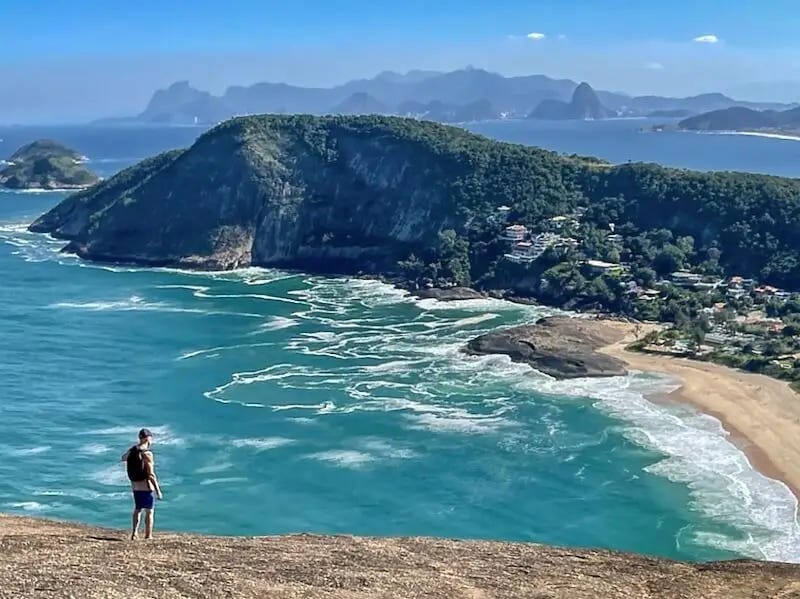
You can get a “helicopter view” of the beach and surf below by taking some tentative steps nearer to the cliff edge – especially just slightly down from the summit. But be careful as there was at least one report of someone falling off during our time in Rio.
Pedra do Elefante
Getting there from Charitas: Get the OC2 bus to Itacoatiara and order an Uber to take you to Mirante de Itaipuaçu (an elevated layby and lookout). The entrance to the trailhead is about 50 metres back along the road from there. Or you could simply order an Uber straight from Charitas.
Named as such because of the headland’s uncanny resemblance to an elephant’s head and trunk, Pedra do Elefante is a trail that straddles the border between Niterói and the neighbouring municipality of Maricá.
The first 45 minutes of the trail are up and down through the rainforest. But then you arrive at a near-vertical slab of granite, where you might wonder where the actual trail has disappeared. There’s no option but to use both your hands and legs to scale this section – and it does require some reasonable leg strength to propel yourself upwards at times. However, it’s not full-on climbing and there are plenty of footholds to pick your route up.
After about 30 metres of steady climbing, the trail reappears and you get your first view to the south of Itacoatiara and Rio.
Once at the top, the south-facing panorama disappears. But, in its place, another sensational view of beaches (Itaipuaçu and Maricá) that stretch to the horizon. And behind, lakes give way to another range of mountains and the occasional rocky outcrop.
Other hikes to consider
Frankly, there are so many hiking options in and around Rio, the most difficult decision will be which ones to leave out. Our six recommendations will hopefully give you a start. But we’ve heard good things about some other hikes we have on our radar for the next visit.
For instance, the Pica da Tijuca and Parrot’s Beak trails are lung-busting climbs to two of the highest points in Tijuca National Park.
South of Rio, the Transcarioca Trail between Barra de Guaratiba and Grumari takes in some fabulously wild beaches. And, for Instagram fans, Pedra do Telegrafo provides a photo opportunity that makes it seem like the subject is balancing (or dangling) precariously on the edge of a cliff – when, in fact, it’s a harmless optical illusion.
Meanwhile, the hike to the top of the monolithic Pedra de Gávea (opposite Pedra Bonita) includes a 30-metre section requiring ropes and a guide. And the Morro de Corcovado trail ignores the option to take the tourist train or van up to the Christ the Redeemer statue by winding its way up through the forest.
Oh, and when you get to the top, look out for the Elvis fan…
Final thoughts on the best hikes in Rio de Janeiro
For us, the stunning topography makes hiking in Rio de Janeiro an absolute must for any visitor.
Yes, some of the trails can be tough going – especially in the oppressive heat of the summer months (December to March). However, by selecting those that require a moderate amount of effort and time, but have the payoff of a stupendous view or two, it’s so worth swapping your Havaianas for a pair of sturdy walking shoes at least once during your visit.
And, by choosing one of our recommendations, we guarantee you won’t be disappointed.
MORE ON BRAZIL
The Magnificent Beaches Of Pipa
How To Find The Best Food In Rio de Janeiro
How To Visit Salvador & Its Historic Centre Safely
What did you think? Do you have any recommendations for the best hikes in Rio de Janeiro? Or perhaps you’re planning to visit soon? Either way, we’d love to hear from you so feel free to comment below!



